-
1 of 253523 objects
Armour of Henry, future Prince of Wales, for the tilt c. 1607
iron, blueing, gold, leather | RCIN 72830

France
Armour of Henry, future Prince of Wales, for the tilt c. 1607
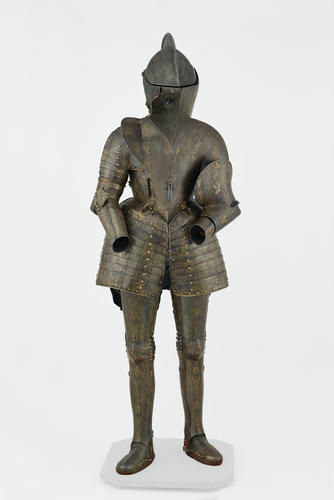
France
Armour of Henry, future Prince of Wales, for the tilt c. 1607
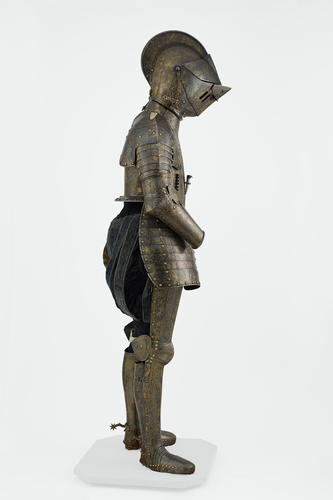
France
Armour of Henry, future Prince of Wales, for the tilt c. 1607

France
Armour of Henry, future Prince of Wales, for the tilt c. 1607
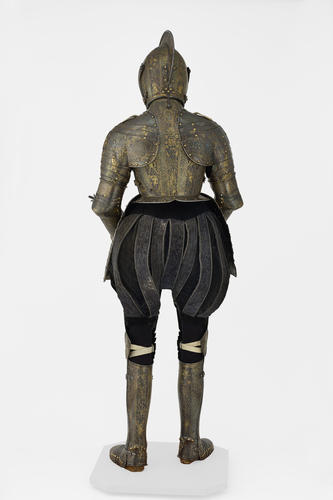
France
Armour of Henry, future Prince of Wales, for the tilt c. 1607
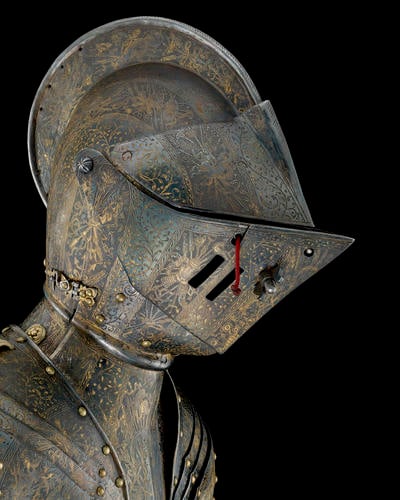
France
Master: Armour of Henry, future Prince of Wales, for the tilt c. 1607

France
Master: Armour of Henry, future Prince of Wales, for the tilt c. 1607
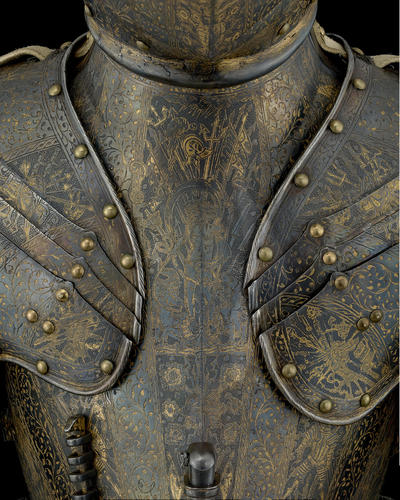
France
Master: Armour of Henry, future Prince of Wales, for the tilt c. 1607

France
Armour of Henry, future Prince of Wales, for the tilt c. 1607
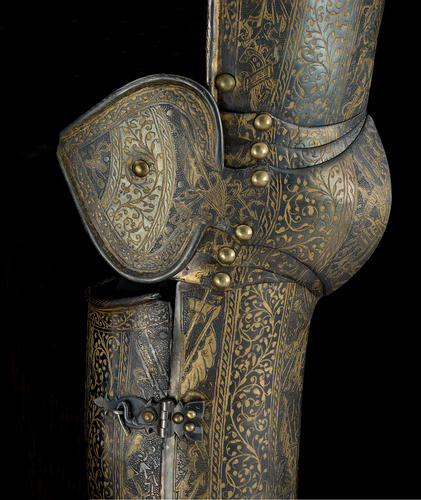
France
Armour of Henry, future Prince of Wales, for the tilt c. 1607
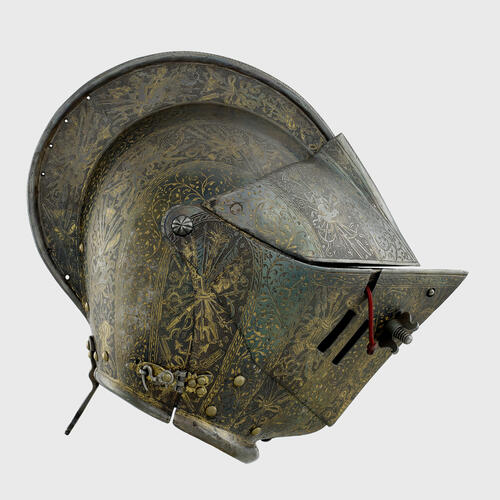
France
Master: Armour of Henry, future Prince of Wales, for the tilt c. 1607
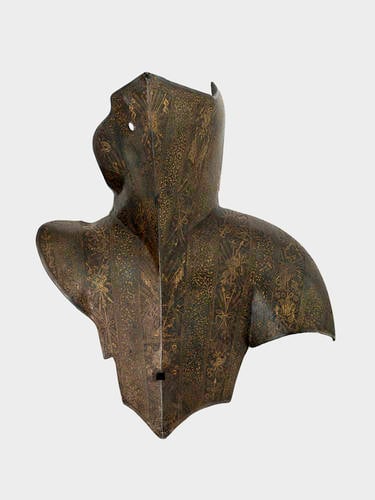
France
Master: Armour of Henry, future Prince of Wales, for the tilt c. 1607
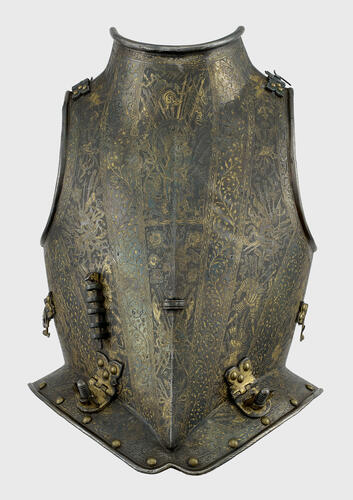
France
Master: Armour of Henry, future Prince of Wales, for the tilt c. 1607
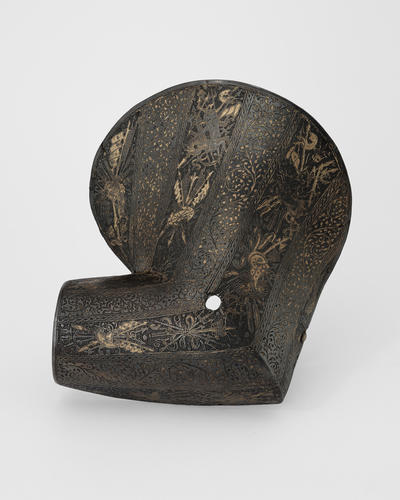
France
Master: Armour of Henry, future Prince of Wales, for the tilt c. 1607
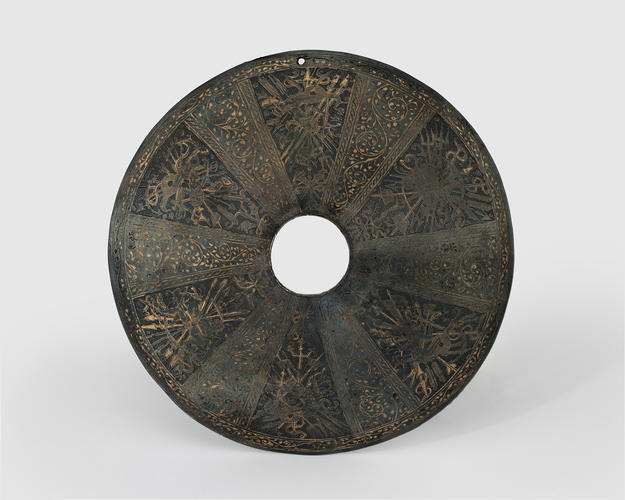
France
Master: Armour of Henry, future Prince of Wales, for the tilt c. 1607

France
Master: Armour of Henry, future Prince of Wales, for the tilt c. 1607
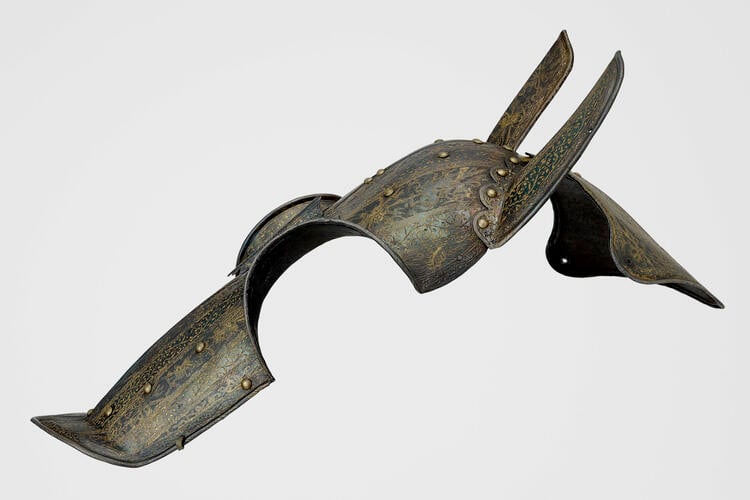
France
Master: Armour of Henry, future Prince of Wales, for the tilt c. 1607

















-
Armour for the tilt consisting of a close helmet, a breastplate, a backplate, a pair of tassets, a pair of slightly asymmetrical pauldrons, a pair of vambraces, a pair of complete legharness, a grandguard, a pasguard, a vamplate and a full shaffron.
The etched decoration consists of broad bands of military trophies pendent on ribbons, alternating with slightly narrower bands of foliate scrolls. In the bands with the trophies the outlines of the objects making up the trophies all stand in relief against a densely dotted and scratchy ground, in the style now called aux motifs glorieux. As well as weapons, the trophies include naked captives, mermen blowing conches, fighting tops of ships, darts, anchors, oars and tridents. Alternate bands are etched in line and gilt with wiry scrolls bearing small comma-shaped and circular leaves recessed into a plain ground. Etched in line and gilt between each pair of these broad bands are narrow bands of stylised, rather loosely twisted cabling, enclosed in each case between two pairs of lines.
The turned edges are followed by narrow bands etched with wiry scrolls with comma-shaped leaves and circular fruit, in each case enclosed by a pair of parallel lines and gilt on a plain ground. The various hasps and swivel-hooks of the armour are fire-gilt. The original swivel-hooks are shaped like scythes with small thumb-pieces on the corners. The free edges of all the plates, except the reinforces, are turned inwards and lightly roped with a file. The edges of the transverse plates are cusped at the points where they are intersected by a vertical arris. On the pauldrons, couters and sabatons the edges of plates adjacent to pivoting rivets are slightly cusped. The visible rivets, some of which are of iron with brass caps and others all of brass, are probably all replacements.
The armour retained some of its original blued surface until the early nineteenth century, when it was burnished. In 1857 it was consequently described as being of bright steel. The present blueing was applied in 1902. Prince Henry wears the armour in a portrait at Dunster Castle, Somerset, painted some time after his inauguration as Prince of Wales in 1610. It shows that although the colour-scheme of the armour at that time was much as it is today, its decoration was then picked out in vermillion, white and either black or very dark blue. The piccadills and straps were covered with crimson velvet edged with gold thread.
The figure of Neptune at the top of the breastplate is based on an engraving formerly attributed to Giorgio Ghisi (1520–82), after Perino del Vaga. Neptune was an appropriate device for the heir to a maritime nation. In a masque held at Whitehall on 5 June 1610, two days after Henry had been installed as Prince of Wales, Queen Anne, in the guise of Thetis, wife of Neptune, presented King James with a trident and the Prince with a rich sword and a scarf. The tilting on the following day was followed by ‘a gallant Sea-fight’ and a display of fire-works.
The trophies on the armour are very similar to those published by Hans Vredeman de Vries (1527-c.1607) in his Panoplia sev armamentarium ac ornamentis published in Antwerp in 1572, although none is identical.
The curious balls (fire-balls), originally coloured vermillion, from which emerge gun-barrels, are similar to those illustrated in various contemporary books of military instruction, for instance La Pyrotechnie de Hanzelet Lorraine, Pont-à-Mousson, 1630. They were projected from mortars.
Tests undertaken at the centre of the lower rear edge of the skull of the Prince’s helmet show it to have a microhardness varying in the range 149–84 VPH (average 166 VPH). It is composed largely of iron with numerous slag-inclusions within which occur irregular bands of carburised iron (pearlite) with carbon contents of up to about 0.2–.3%.
Text adapted from Norman, A.V.B, & Eaves, I. 2016. Arms and Armour in the Collection of Her Majesty The Queen: European Armour, London.
Metallurgy by Williams, A, & Metcalf, S. 2016. Summary of the metallurgy of European Armour in the Royal Collection. London. Appendix II of Norman & Eaves
Measurements: Helmet: height: 27.9 cm, width 19.7 cm, depth 35.3 cm; Breastplate: height from shoulders to point of waist 36.5 cm, height from centre of neck to point of waist 37.8 cm, height from centre of neck to edge of skirt 40.4 cm, width beneath arm-openings 28.0 cm, width at waist 21.9 cm; Lance-Rest Retaining-Pin: length 7.1 cm; Backplate: height 41.9 cm; Right Tasset: height 36.2 cm, width 30.2 cm; Left Tasset: height 35.7 cm, width including flange 31.1 cm; Right Pauldron and Vambrace: length 60.4 cm, width of pauldron 19.7 cm; Left Pauldron and Vambrace: length 59.1 cm, width of pauldron 19.7 cm; Right Legharness: height of cuisse and poleyn 36.9 cm, height of front of greave 42.7 cm, height of centre of knee to ground 46.1 cm, length of foot 22.9 cm; Left Legharness: height of cuisse and poleyn 38.1 cm, height of front of greave 42.6 cm, height of centre of knee to ground 45.7 cm, length of foot 22.9 cm; Grandguard: height 47.2 cm, width 43.4 cm; Pasguard: height: 25.1 cm; width: 26.4 cm; Vamplate: external diameter 27.8 cm, diameter of central aperture 4.8 cm, length 11.5 cm; Shaffron: height 58.1 cm, width 22.4 cm.
Weights: Helmet: 3.317 kg; Breastplate: 1.531 kg; Backplate: 1.191 kg; Right Tasset: 1.417 kg; Left Tasset: 1.588 kg; Right Pauldron and Vambrace: 1.984 kg; Left Pauldron and Vambrace: 2.041 kg; Right Legharness: 1.871 kg; Left Legharness: 2.155 kg; Grandguard: 2.282 kg; Pasguard: 1.021 kg; Vamplate: 0.624 kg; Shaffron: 1.304 kg.Provenance
This armour was previously thought to have belonged to Charles I (1600-49) when Prince of Wales. It is listed as no. 3 in the third group recorded in the manuscript 'An Account of the Armour and Arms in the Guard Chamber at Windsor Castle', prepared by the Board of Ordnance at the Tower of London, and dated 29 July 1831, as that of ‘Prince Charles A.D. 1620’.
More recently, however, it has been suggested that the armour is that given to Prince Henry by Henri IV of France, for which the Prince wrote to thank him on 21 July 1607. Monsieur St Antoine, the Prince’s riding master, had apparently suggested to the French ambassador, Monsieur Antoine le Fevre de la Boderie, that the Prince might greatly appreciate the gift of ‘a suit of armour well gilt and enamelled, together with pistols and a sword of the same kind …’.
In 1607 one of the men who bore the title Armurier royal and might therefore have been expected to make this armour was Guillaume Huguet. However, the title was not exclusive and other craftsmen are known to have borne it at this time. The mark on the inside of the left tasset remains unidentified. The armour is one of only two French tilt armours known to survive.
The 1629 Remain of the Armouries lists ‘One Tilte Armor parcell guilte and graven given Prince Henry by the King of ffraunce Compleate in a Truncke excepting Gauntlettes and Mainefree’. This is repeated almost word for word in the 1630/1 Remain. It may, therefore, be assumed that since there is no reference to the blueing and enamelling visible in the Dunster portrait, the armour had been re-finished and its enamel removed before 1629.
The armour may also be the ‘Small Tilt Armour cap a pe, richly gilt and chased wanting only Gantletts and Manifare, with a Shaffron of the same’, recorded in the 1660 Remain among the items rescued by Edward Annesley from Greenwich. In the Inventory of 1675–9 the following entry probably refers to the same armour; ‘Small Suite of Armor richly guilt & graven consisting of back, brest, headpeece, a par of short cushes Poldrons & Vambraces, Graves & Knee Copps, a Pass Guard, grand Guard, Vamplettes and Shaffons’. Since this is not identifiable in any later inventory of the Tower Armouries, it had presumably been sent to another palace.
Items 2038 and 2050 in the North Corridor Inventory which records the arrangement of the collection in the North Corridor at Windsor Castle. -
Medium and techniques
iron, blueing, gold, leather
Category
Object type(s)
Other number(s)
Alternative title(s)
Armour for the tilt of Henry, Prince of Wales
Place of Production
France